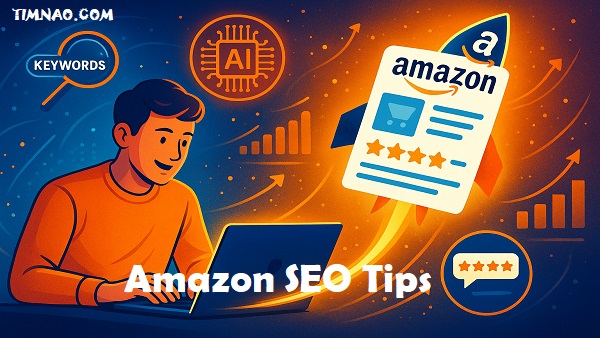🚀 The Ultimate Guide to Amazon SEO: A Powerful Strategy to Avoid Failure and Boost Your Sales!
This guide to powerful Amazon SEO tips is your comprehensive roadmap to navigating the exciting world of selling on Amazon. If you’re a beginner Amazon seller just starting, the platform can feel like a vast, complex universe. You have a great product, but a critical question looms: “How will customers find me?” This is where mastering Amazon’s unique form of Search Engine Optimization (SEO) becomes not just helpful, but absolutely essential to boost Amazon sales.
The reality of Amazon is that visibility is everything. With millions of sellers and hundreds of millions of products, simply listing your item is like placing a single grain of sand on a massive beach. Over 70% of Amazon shoppers never venture past the first page of results. Your mission, should you choose to accept it, is to understand how Amazon’s search engine thinks, so you can claim your spot on that coveted first page.
This article is designed to be your roadmap. We will break down complex topics into 11 powerful, actionable strategies you can implement right away. From decoding Amazon’s algorithm to leveraging the power of Artificial Intelligence, you’ll gain the confidence and skills needed to turn your Amazon venture into a thriving business.
Table of Contents
- Strategy 1: 🧠 Decode the A9 Algorithm
- Strategy 2: 🔑 Master Your Keyword Research
- Strategy 3: ✍️ Craft High-Impact Product Titles
- Strategy 4: 🎯 Write Persuasive, Benefit-Driven Bullet Points
- Strategy 5: 📖 Tell a Compelling Story with Descriptions & A+ Content
- Strategy 6: 🖼️ Optimize Your Visual Content (Images & Video)
- Strategy 7: 🕵️♂️ Leverage Hidden Backend Keywords
- Strategy 8: 🌟 Build Social Proof with Customer Reviews
- Strategy 9: 🤖 Apply Artificial Intelligence for a Competitive Edge
- Strategy 10: 👨👩👧👦 Group Products with Variations for Higher Visibility
- Strategy 11: 🏰 Build a Long-Term Brand on Amazon
Strategy 1: 🧠 Decode the A9 Algorithm
Before you can win the game, you have to learn the rules. The very first strategy is to understand the system you’re working with: Amazon’s A9 search algorithm. Unlike Google, which aims to answer questions, A9 has one primary goal: to sell products. Every factor it considers is geared towards predicting what a customer is most likely to buy, making this one of the most important Amazon SEO tips to internalize.
Think of A9 as Amazon’s ultimate matchmaker. When a shopper types in a search query, A9 instantly scans millions of listings to find the most relevant products that have the highest probability of resulting in a sale. This is a crucial distinction. While Google might prioritize a well-researched blog post, Amazon will always prioritize a product listing that it believes will convert a browser into a buyer.
The A9 algorithm primarily operates on two core pillars: relevance and performance.
-
Relevance: This is how well your product listing matches a customer’s search term. A9 scans your product title, bullet points, description, and hidden backend keywords to determine if your product is a good fit. The more aligned these elements are with what customers are searching for, the better your initial relevance score.
-
Performance: This is all about how well your product sells. A9 closely monitors metrics like your click-through rate (how many people click on your product after seeing it), conversion rate (how many clicks turn into purchases), and overall sales velocity. Strong performance signals to Amazon that your product is desirable, which in turn boosts your ranking over time.
Customer satisfaction also plays a massive role in performance. Positive reviews, high ratings, and a low return rate tell Amazon that customers who buy your product are happy with their purchase. This reinforces the idea that your product is a good choice, encouraging A9 to show it to more people and solidifying your rank.
Strategy 2: 🔑 Master Your Keyword Research
Keywords are the absolute foundation of your Amazon business. They are the language shoppers use to tell Amazon what they want, and your job is to speak that language fluently. For any beginner Amazon seller, a solid keyword research strategy is the single most impactful activity you can undertake to boost Amazon sales. Every part of your listing is built upon this research.
The goal isn’t just to find popular terms; it’s to find the right terms for your specific product. You need to identify keywords that have a healthy search volume and, most importantly, high relevance to your item.
First, brainstorm “seed” keywords. These are the broad, foundational terms for your product, like “yoga mat” or “exercise mat.” Use Amazon’s own search bar for ideas; its autocomplete feature shows you what real shoppers are looking for.
Next, expand your search to include long-tail keywords. These are longer, more specific phrases like “eco-friendly non-slip yoga mat for hot yoga.” While they have lower search volume individually, they often have much higher conversion rates because the customer’s intent is so precise. A shopper searching with that level of detail is ready to buy.
Finally, legally and ethically spy on your competition. Analyze the top-selling products in your category and see what keywords they use in their titles and bullet points. Powerful tools like Helium 10 and Jungle Scout can automate this process, revealing the exact keywords your competitors are ranking for and giving you a treasure trove of proven ideas.
Strategy 3: ✍️ Craft High-Impact Product Titles
Your product title is your digital handshake. It’s the first thing shoppers see in the search results and it carries immense weight in Amazon’s ranking decision. A powerful title strategy involves creating a title that is clear, descriptive, and strategically packed with your most important keywords.
A proven formula that works wonders is to place your primary keyword at the very beginning of the title. This immediately signals its relevance to both the A9 algorithm and the customer. From there, you should weave in other important keywords while also providing essential product details.
A great title balances keywords with key information. Include details like your brand name, the product’s primary material, quantity, size, or color to help shoppers quickly understand your offer and why it’s right for them. This reduces friction and encourages more clicks.
For example, instead of a weak title like “Yoga Mat,” a much more effective, strategy-driven title would be: “ZenFlow Pro Yoga Mat | Eco-Friendly TPE Non-Slip | Extra Thick 6mm for Comfort | Perfect for Hot Yoga & Pilates – Midnight Blue.” This title is rich with keywords, provides valuable information, and is far more likely to attract qualified buyers.
Strategy 4: 🎯 Write Persuasive, Benefit-Driven Bullet Points
Many shoppers are skimmers, not readers. They will glance at your listing for key information before deciding to buy, which makes your bullet points incredibly important real estate. Your strategy here is to create a concise, scannable summary of your product’s most important aspects, focusing on benefits over features.
This is a prime opportunity to naturally integrate more of your secondary keywords. The key is to translate features into benefits. Don’t just state a technical detail; explain how that detail improves the customer’s life.
Instead of saying “Made from TPE material,” say “Enjoy Unmatched Comfort & Stability with our Eco-Friendly, TPE Non-Slip Surface.” See the difference? The second version connects with a customer’s needs. Each bullet point should begin with a capitalized, attention-grabbing benefit to draw the eye.
Use your bullet points to preemptively answer common questions or address potential concerns. If your product is a specific size or requires special care, mention it here. By addressing these points upfront, you build confidence and increase your conversion rate, which is a powerful signal to the A9 algorithm.
Strategy 5: 📖 Tell a Compelling Story with Descriptions & A+ Content
The product description is your chance to move beyond quick sales pitches and tell a deeper story about your product and brand. While not as heavily weighted for direct SEO ranking as the title and bullets, this section is still indexed by Amazon and is absolutely crucial for converting shoppers who are on the fence and want more information before they commit to a purchase.
Use this space to paint a picture of how your product will solve a problem or enhance the customer’s life. Talk about the quality of the materials, the care that went into the design, or the mission of your brand. Break up the text into short, easy-to-read paragraphs to maintain engagement.
If you are a brand-registered seller, your strategy here gets a major upgrade with A+ Content. This powerful feature allows you to replace the plain text description with a visually stunning layout of rich media, including professional images, comparison charts, and branded visuals. A+ Content has been shown to significantly boost engagement and can increase conversion rates by up to 10%.
Strategy 6: 🖼️ Optimize Your Visual Content (Images & Video)
In the world of e-commerce, your product photos are your storefront, your salesperson, and your packaging all in one. A strategy of using high-quality visuals is non-negotiable on Amazon; they build trust, showcase your product’s value, and have a direct impact on your conversion rate. The A9 algorithm rewards listings with strong visual content because they lead to more sales.
Your main image is the hero. It’s the image that appears in search results and is the first thing shoppers see on your page. It must be perfect. Amazon requires this image to be on a pure white background, shot in high-resolution (at least 1000 pixels on the longest side to enable zoom), and feature only the product itself.
Use your supplementary image slots to tell a complete visual story. Show your product from multiple angles, include close-ups of important textures or features, and, crucially, use lifestyle images that show the product in a real-world setting. This helps customers visualize themselves using it, bridging the gap between Browse and buying. You can also dedicate a slot to an infographic that highlights key benefits or dimensions.
If possible, add a product video. It is one of the most effective ways to boost Amazon sales. A short, 30-60 second video can demonstrate how your product works, showcase its quality, and build an emotional connection in a way that static images simply cannot.
Strategy 7: 🕵️♂️ Leverage Hidden Backend Keywords
One of the most underutilized strategies by beginner Amazon sellers is optimizing the backend of their listing. What shoppers don’t see can be just as important for your Amazon SEO as what they do. In your Amazon Seller Central account, you have access to backend fields where you can input hidden search terms. This is your secret weapon for ranking for a wider range of keywords.
This is the perfect place to include all the relevant search terms that didn’t fit naturally into your title or bullet points. Think of synonyms (“sneakers” for “running shoes”), common misspellings that shoppers might type, abbreviations, and even relevant terms in other languages, like Spanish, if applicable to your audience.
The key is to use this space wisely. Amazon gives you a character limit (typically around 250 bytes), and you should never repeat keywords that are already in your visible listing content (title, bullets, etc.). Repeating words wastes valuable space and provides no extra SEO benefit. To maximize the space, simply separate your keywords with spaces—no commas or other punctuation are needed.
Strategy 8: 🌟 Build Social Proof with Customer Reviews
Customer reviews are the digital equivalent of word-of-mouth marketing, and they are the lifeblood of your Amazon listing. A strategy focused on generating and maintaining positive reviews is one of the most powerful things you can do for your business. Reviews are a top factor in the A9 ranking algorithm because they provide social proof, which heavily influences conversion rates.
A product with a high number of positive reviews is seen as a trustworthy, high-quality item. This makes it an easy choice for shoppers and a favorite of the A9 algorithm, which will show it to more people. The best way to get reviews is to earn them by providing an excellent product and outstanding customer service.
To be more proactive, you can use Amazon’s “Request a Review” button found on your orders page in Seller Central. This sends a standardized, policy-compliant email to the customer asking for feedback. Never, ever offer incentives or compensation for reviews, as this is a strict violation of Amazon’s policies.
Even negative reviews can be part of your strategy. While disheartening, they are an opportunity. Always respond to them publicly in a professional and polite manner. This shows other potential customers that you are an engaged seller who stands behind your product. Furthermore, analyze your negative feedback for patterns; it can provide invaluable free advice on how to improve your product or listing.
Strategy 9: 🤖 Apply Artificial Intelligence for a Competitive Edge
This is where the game truly changes for the modern Amazon seller. Your ninth strategy is to embrace the future and leverage Artificial Intelligence. AI is no longer a futuristic buzzword; it’s a practical and accessible tool that can supercharge every aspect of your Amazon SEO. Using AI can save you countless hours and provide data-driven insights that give you a massive competitive advantage.
AI-Powered Keyword Research
AI can make the tedious process of keyword research faster and more comprehensive. It can uncover hidden, long-tail keywords and analyze search intent at a scale that is impossible to do manually.
- Practical Application: Let’s return to our yoga mat seller. You can use a general AI tool like Google Gemini or ChatGPT and prompt it: “I sell a premium, eco-friendly yoga mat. Give me 50 long-tail keywords a potential customer might use to find this product on Amazon. Include keywords related to its features, like ‘non-slip’ and ‘extra thick,’ as well as user problems, like ‘yoga mat for sore knees’ or ‘travel-friendly yoga mat’.” The AI will instantly generate a list you can use to optimize your listing.
AI for Compelling Listing Optimization
Struggling with writer’s block? AI can act as your personal copywriter, generating high-quality titles, bullet points, and descriptions that are optimized for both keywords and conversions.
- Practical Application: Feed your target keywords to an AI with a prompt like: “Write 5 SEO-optimized bullet points for an Amazon listing for my ‘ZenFlow Pro Yoga Mat.’ My primary keywords are ‘eco-friendly yoga mat,’ ‘non-slip TPE mat,’ and ‘thick exercise mat.’ Start each bullet with a capitalized benefit and keep each one under 200 characters. The tone should be inspiring and supportive.” AI can generate multiple versions in seconds, allowing you to choose the best one.
Smarter Amazon Advertising with AI
Amazon PPC advertising is powerful but can be complex and expensive. AI-powered advertising tools, like those from Teikametrics or within suites like Helium 10, can automate bidding, suggest new keywords based on performance, and optimize your ad spend to ensure you get the best possible return.
AI-Driven Data Analysis and Competitor Insights
The most successful Amazon sellers are data-driven. AI can sift through mountains of sales reports and customer reviews to pull out actionable insights that would take a human days to find.
- Practical Application: Copy and paste dozens of your competitor’s negative reviews into an AI platform and ask, “Analyze these reviews and identify the top 5 most common complaints about my competitor’s yoga mat.” The AI might reveal that customers complain about a chemical smell or poor durability. You can then use this intelligence to highlight your product’s odor-free and durable qualities in your own listing, directly targeting a known market weakness.
Strategy 10: 👨👩👧👦 Group Products with Variations for Higher Visibility
As you grow, you need to employ more advanced tactics. A powerful scaling strategy is to use product variations, also known as parent-child listings. If you sell a product that comes in different sizes, colors, flavors, or styles, you should group them together on a single product page rather than creating separate listings for each.
This strategy has several huge benefits. First, it dramatically improves the customer experience by allowing shoppers to see and select all available options in one convenient place. This reduces confusion and makes it easier for them to find exactly what they want.
More importantly for SEO, variations consolidate your sales velocity and customer reviews. All reviews for all child products are pooled together on the parent listing, helping you accumulate social proof much faster. Likewise, a sale of any variation contributes to the sales history of the entire product family, which can significantly boost the search ranking for all of your variations.
Strategy 11: 🏰 Build a Long-Term Brand on Amazon
Our final strategy is about playing the long game. To move from just being a seller to building a truly sustainable business, you must focus on building a brand. A strong, recognizable brand can attract loyal customers, command higher prices, and provide a durable competitive advantage.
The first step is to enroll in Amazon’s Brand Registry program if you are eligible. This is a critical move that unlocks a suite of powerful brand-building tools, including the A+ Content feature we discussed earlier, your own customizable Amazon Storefront, and access to Amazon Brand Analytics, which provides invaluable data on customer demographics and search behavior.
Use these tools to create a consistent and professional brand identity across all your touchpoints. Your Amazon Storefront acts as your own mini-website on Amazon, where you can showcase your brand story and entire product catalog. You can drive traffic to your store using Sponsored Brands ads, creating a cohesive brand experience that builds trust and encourages repeat business. A strong brand is what will allow you to thrive on Amazon for years to come.
Reference video:









I truly appreciate your technique of writing a blog. I added it to my bookmark site list and will